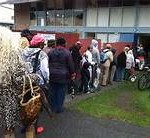By Beth Dixon
 Beth Dixon is a Professor of Philosophy at the State University of New York at Plattsburgh. She visited UVM recently for a faculty workshop on the ethics of eating. We invited her to share some of her thoughts on the complex issue of food justice.
Beth Dixon is a Professor of Philosophy at the State University of New York at Plattsburgh. She visited UVM recently for a faculty workshop on the ethics of eating. We invited her to share some of her thoughts on the complex issue of food justice.
In The American Way of Eating, Tracie McMillan concludes her year of investigative reporting with this remark, “Food is not a luxury lifestyle product. It is a social good.” If food is a social good, then we should ask how to make nutritious food available to all people irrespective of their social and political location. Perhaps one way to make progress in this area of social justice is to identify the various ways in which food choices are constrained by structural inequities that create obstacles to being adequately nourished.
For example, how hard is it to follow the “eater’s manifesto” described by Pollan’s very inspiring book, In Defense of Food? This depends on who you are and the constraints on food choices created by your particular circumstances. The kinds of circumstances that constrain the freedom to eat nutritious food include: lack of money, lack of time, no transportation, no accessible place to shop, diminished physical mobility, or ineffectual public policy at the local, state, federal, or global levels that restricts access to food.
Food pantry recipients will have a hard time following Pollan’s advice to, “Pay more, eat less.” Those living in low income urban areas where there are “grocery gaps” may have trouble finding a place where food is sold that is not also a fuel stop for cars. Seniors who use a walker may not avail themselves of the local farmers’ markets even when there is public transportation that connects living and shopping areas. Some seniors also may find it difficult to follow Pollan’s suggestion not to eat alone. And those who work two or three jobs for minimum wage will not have the energy or time to “cook, and plant a garden.”
In many settings, the key to create easier access to nutritious food for people whose choices are constrained in these ways is social and political change. But local, state, federal and global policy and regulations involving food are subject to a variety of interest groups. These social and political conditions are not under the control of particular individuals who lack political power and influence.
Let’s explore Pollan’s suggestions through the lens of some food justice stories that highlight some of these constraints:

(1) “Cook and, if you can, plant a garden”
- Watch The Garden, a documentary film produced by Scott Hamilton Kennedy.
- Watch Ron Finley, a guerrilla gardener in South Central L. A.
- Visit your local food pantry

(3) “Don’t get your fuel from the same place your car does”
- Listen to a report from People’s Grocery in West Oakland, CA
- Consider those in senior living facilities
If we can identify the faces of those who are not free to choose nutritious food, we are one step closer to identifying why this is so; and one step closer to proposing solutions to correct for inequality of access to fresh, nutritious food.












